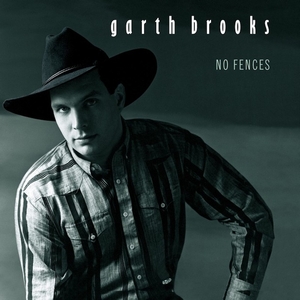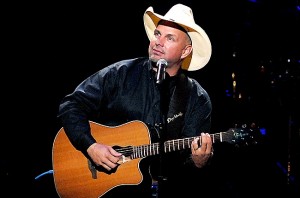
In 1990, Garth Brooks released his second studio album, No Fences. This album was the one, according to Kathy Coleman in her review, which “blasted Brooks out of the rest of the pack of the late-blooming neo-traditionalists and set him on a path that…no one else could follow without bending the genre so far it broke” (Coleman). Not only would this be the first Garth album to reach No. 1 on the US country charts and No. 3 on the US pop charts, making it his first crossover album, but in addition, all four singles would reach No. 1 on the country charts and the album itself would go on to sell over ten million copies worldwide. No Fences has become the best selling Garth album of all time and its release would launch him into a realm of superstardom that had not yet been achieved by any other artist. As Paul Kingsbury says in his book, “While [other country artists] would sell millions of albums, it would be Brooks who redefined country music” (Kingsbury 322).
Garth Brooks was born on February 7, 1962, in Tulsa, Oklahoma. His mother had been a singer before marrying his father, and he learned to play guitar and sing with her in his early years. He joined a band during high school, but his primary interest was sports, and he attended Oklahoma State University on a track scholarship. After graduating, Brooks decided to devote himself to music. He briefly moved to Nashville in 1985 but found little luck there. After he had moved back to Oklahoma, married, and saved some money, he decided to try Nashville again. His persistence paid off when a Capitol Records talent scout spotted him in a club and signed him. It’s a good thing too, because Brooks became, according to his Rolling Stone biography, “the most stunning success story of the early-Nineties contemporary country music boom”. Having sold more than 100 million albums since his debut, Brooks has become the best-selling solo artist in history and has led the way in creating the country-pop subgenre and redefining country music.
In the beginning, Garth’s debut album had the typical neo-traditionalist sound of the 1980s much like George Strait, with hits like “The Dance” and “If Tomorrow Never Comes”. At this point, “Garth was still pretty much just a country boy from Oklahoma and he sang, by and large, plain old country music” (Coleman). However, neither this sound nor image would last very long for him with the release of No Fences.
No Fences would become a major turning point in Garth’s career. This album was where Brooks started getting bolder and began his blend of country and pop music, which would ultimately lead to his distinct sound, which is a “curious, highly profitable amalgam of everything” (Kingsbury 322). Growing up, Billy Joel, Queen and other rock and roll performers had influenced Garth, and these influences can definitely be heard in his recordings. From the electric guitar solo in “Friends in Low Places” to the heavy drum beat in “The Thunder Rolls”, the rock influences begin to show in No Fences. The elements of pop can be heard throughout this album as well, as it blends together sensitive ballads and the pretty, smooth sound of pop music with the honky-tonk feel of country music, which was very much unheard of at the time. When it was originally released, it was impossible to predict the impact No Fences would have, not only on Garth’s career, but also on the way country music would be viewed from that point on.
Not only can the rock and pop influences be heard in the album, but it also came out during Garth’s live shows. Being a huge fan of both Queen as well as Kiss, Garth was notorious for his “flashy stage concerts” that were “filled with 1970s-style arena pyrotechnics” (Kingsbury 325). Garth ushered in country music to the “arena age”, packing huge stadiums with fans and putting on a show filled with lights and fire and all sorts of things people would expect to see at a rock concert, not a country show. Garth was able to pull it off though, and his “savvy musical mix of traditional fiddle-and-steel country, sensitive folk balladry, and rock rave-ups appealed to both a new generation of country enthusiasts as well as fans of ‘70s arena rock” (Kingsbury 325).
From a rhetorical standpoint, No Fences came at a point where Garth was not yet the superstar he is today, but he was still a new, fresh face in country music. He had already had a No. 1 hit with “The Dance” on his debut album Garth Brooks, so he was fairly well known, but his debut album was “stripped-down enough for Brooks to be branded as a neo-traditionalist” (Kingsbury 322). Garth wanted to do something new, something no one in country music had done before. He had seen how fans reacted to his slow ballad, “The Dance” during his live shows, and he knew he wasn’t the only one with a love for electric guitar riffs and flashing lights, so he combined the two. Garth’s release of this new album and sound could not have come at a better time for him. The producers in Nashville were looking for a new sound of country music, and he delivered. At this point in time, they were trying to move away from the popular neo-traditionalist sound and trying to find something completely new and unheard of. Garth Brooks gave them the sound they were looking for. No Fences’ effortless blending of pop and rock into the neo-traditionalist country sound appealed greatly to the producers, and Garth quickly became the new face of country music. All four single off of No Fences reached No.1 on the US country charts, and the album itself reached No. 1 on the country charts as well as No. 3 on the US pop charts, making it Garth’s first album to crossover into the world of pop music. Fans eagerly scooped the album off the shelves upon its release, and Garth also ended up winning Entertainer of the Year in 1991 for his live performances. The producers loved it, the people loved it, and Garth had begun to change country music.
In addition to buying up record numbers of the album, Garth’s fans also began to notice how the sound of his music was transforming and maturing during this time. As Mike London puts it in his review on Amazon, “With “No Fences”, the pop/rock influences become widely apparent in Garth’s music, especially the ballads, marrying the folk-rock and the bombastic conventions of the power ballad seamlessly. The music is much more dynamic as well. “The Thunder Rolls” is a chilling ballad, but feels more akin to the songwriting sensibilities of a rock act than traditional country.”
“The Thunder Rolls” had a particularly large impact on bringing about Garth’s crossover into pop music. While the song itself deals with a man who is having an affair with his wife, it was the music video that was responsible for a great deal of controversy in the country music world. The video deals with domestic violence, and Garth Brooks himself plays the role of the abusive male in the video. On May 1, the day after the video’s release, TNN banned the video. CMT pulled it soon after, as they believed it was promoting domestic violence, which was obviously not Garth’s intent. However, while country music television would not air the video, VH1 would. While they generally only played pop videos, they chose to play the music video for “The Thunder Rolls” which allowed not only for the raise in awareness of domestic violence, as Brooks had hoped, but it also allowed Brooks to be seen and heard by a completely different group of people and gaining new fans, adding even more to his developing crossover effect.
No Fences really put Garth Brooks on both the country and the pop music map. While he had some success with his debut, self-titled album, No Fences really set the standard for Garth’s musical career. He successfully crossed over to the realm of pop music, and while many people think that crossing over is one of the worst things to happen to country music, there is no doubt that Garth successfully brought country music outside the normal country markets and into the lives of many people who would have never started listening if it were not for him. For that, the country music industry is forever in debt to Garth. For better or worse, he revolutionized country music, and that revolution largely began right here, with No Fences.
Tracks:
- “The Thunder Rolls” (Pat Algar, Garth Brooks)
- “New Way to Fly” (Kim Williams, Brooks)
- “Two of a Kind, Workin’ on a Full House” (Bobby Boyd, Warren Haynes, Dennis Robbins)
- “Victim of the Game” (Mark D. Sanders, Brooks)
- “Friends in Low Places” (DeWayne Blackwell, Earl “Bud” Lee)
- “Wild Horses” (Bill Shore, David Wills)
- “Unanswered Prayers” (Alger, Larry Bastian, Brooks)
- “Same Old Story” (Tony Arata)
- “Mr. Blue” (Blackwell)
- “Wolves” (Stephanie Davis)
Works Cited:
Coleman, Kathy. “Garth Brooks – No Fences Review – Review of Garth Brooks’ No Fences CD.” About.com Entertainment. N.p., n.d. Web. 01 Mar. 2015.
Kingsbury, Paul. “Pocketful of Gold.” Will the Circle Be Unbroken? By Paul Kingsbury. N.p.: n.p., n.d. 322-49. Print
Mike London. “Here’s where Garth gets Interesting.” Amazon. Amazon, 30 Nov. 2012. Web. 8 Mar. 2015.
Simon and Schuster. “Garth Brooks.” Rollingstone.com. Rolling Stone, n.d. Web. 8 Mar. 2015.

